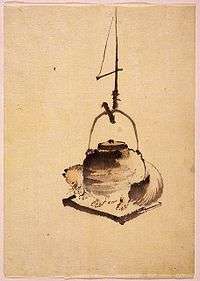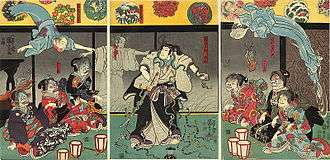Japanese folklore
Japanese folklore encompasses the folk traditions of Japan and the Japanese people.
In Japanese, the term minkan denshō (民間伝承 "transmissions among the folk") is used to describe folklore; the study of folkloristics is known as minzokugaku (民俗学). Folklorists also employ the term minzoku shiryō (民俗資料) or "folklore material" (民俗資料) to refer to objects and arts they study.
Folk religion
Men dressed as namahage, wearing ogre-like masks and traditional straw capes (mino) make rounds of homes,[1] in an annual ritual of the Oga Peninsula area of the Northeast region. These ogre-men masquerade as kami looking to instill fear in the children who are lazily idling around the fire. This is a particularly colorful example of folk practice still kept alive.
A parallel custom is the secretive Akamata-Kuromata ritual of the Yaeyama Islands, Okinawa which does not allow itself to be photographed.[2][3]
Many, though increasingly fewer households maintain a kamidana or a small Shinto altar shelf.[4] The Shinto version of the kitchen god is the Kamado kami (かまど神), and the syncretic Buddhist version is the Kōjin, a deity of the hearth enshrined in the kitchen.
Japanese popular cults or kō (講)[5] are sometimes devoted to particular deities and buddhas, e.g. the angry Fudō Myōō or the healer Yakushi Nyorai. But many cults centered around paying respects to sacred sites such as the Ise Shrine (Ise-kō or okage-mairi) or Mount Fuji (Fuji-kō, by which many local mock-Fuji shrines have been erected). Pilgrimage to these meccas declined after the Edo Period. But recently, the Shikoku Pilgrimage of the eighty-eight temple sites (commonly known as ohenro-san) has become fashionable. Popular media and cottage industries now extoll a number of shrines and sacred natural sites as power spots.
There is a long list of practices performed to ward evil (yakuyoke (厄除け))[6] or expel evil (yakubarai, oharai (yaku-barai)), e.g. sounding the drums.[6] In some areas it is common to place a small mound of salt outside the house (morijio).[7][8] Salt-scattering is generally considered purifying[7] (it is employed in sumo tournaments,[7] to give a well-known example). A stock routine in period or even contemporary drama involves a master of the house telling his wife to scatter salt after an undesirable visitor has just left. Contrarily, lighting sparks with flint just as a someone is leaving the house was considered lucky.
No one now engages in the silent vigil required by the Kōshin cult, but it might be noted that this cult has been associated with the iconic three See no evil, hear no evil, speak no evil monkeys.[9]
There are certain vestiges of geomancy introduced into Japan from China through Onmyōdō. The word kimon, lit. "ogre's gate", colloquially refers to anything that a person may have constant ill luck with, but in the original sense designates the northeasterly direction, considered to be unlucky or dangerously inviting of ill-intended spirits[9] (cf. Konjin). There is also a Japanese version of Feng Shui known as kasō[10] or literally "house physiognomy". Closely connected is the Yin-yang path or Onmyōdō, and its concepts such as katatagae also known as kataimi,[11] which was widely practiced by nobles in the Heian Era. A widely known taboo (kitamakura) advises against sleeping with your head faced north,[12] though it is doubtful if anyone now seriously heeds this prohibition.[12]
Folktales

As in most developed nations, it is increasingly difficult to find living storytellers of oral tradition. But there is a wealth of folktales collected through the ages. The name mukashi-banashi (tales of "long ago" or from "bygone times") has been applied to the common folktale, since they typically open with the formula "Mukashi..."[13] (akin to "Once upon a time..."). They also close with some set phrase like "dotto harai"[13] (a variant form being Dondo Hare).
These tales had been told in their local dialects, which may be difficult to understand to outsiders, both because of intonation and pronunciation differences, conjugations, and vocabulary. Many folktales collected from the field are actually "translations" into standard Japanese (or more like adaptations, merging several collected versions).
Classic folktales
Classic folktales such as Momotarō, which most Japanese today are familiarized through pictured children's storybooks, manga, or other popularizations, can be traced to picture-books printed in the Edo Period, though their prototypical stories may go back much further. The versions retold by children's story author Sazanami Iwaya (1870–1933)[14] had a strong hand in establishing the forms usually known today.
Animals in folktales
Two creatures are particularly known for their abilities to transform into humans or other beings and objects, the kitsune (fox) and tanuki (the raccoon dog; pictured). They occur frequently in folktales of humorous nature.
Marriages between humans and non-humans (irui konin tan (異類婚姻譚 "tales of heterotype marriages")) comprise a major category or motif in Japanese folklore. Japanese heterotype examples such as the crane story describes a sustained period of married life between the interspecies couple, in contrast to Western examples like Frog Prince or the Leda myth where the supernatural encounter is brief. An unusual pairing occurs in the story of the Hamaguri nyōbo (蛤女房 "clam wife"), which exist in both a politer written version (Otogizōshi) and in a more rustic and vulgar oral tale. The gender is reversed in the tale of Tanishi chōja where a bride is wedded to a tiny tanishi (river snail).
Modern renditions
A number of folktales were adapted for stage performance by playwright Junji Kinoshita, notably Yūzuru (Twilight Crane, 1949),[15] based on the folktale Tsuru no Ongaeshi or "a crane who repaid its gratitude".
In the American television series called The Yokai King, starring by Shin Koyamada, the characters are based on the Japanese folklore creatures.
Fantastic creatures

A great deal of interest currently gravitates towards Japanese monsters taken from traditional Japanese sources. Some of the yōkai or strange beings are the stuff of folklore, orally transmitted and propagated among the populace. But one must realize that many beings or stories about them were spun and deliberately invented by professional writers during the Edo Era and earlier, and they are not folkloric in the strict sense.
Folk art and craft
Some well-known craft objects such as netsuke, raccoon dog earthenware (Shigaraki ware), may be classed as Japanese traditional crafts.
A number of articles of daily household use (mingu (民具)), amassed by Keizo Shibusawa, became the Attic Museum collection, now mostly housed in the National Museum of Ethnology in Suita, Osaka. The Mingei movement spearheaded by Yanagi Sōetsu sought to appreciate folk craft from an aesthetic viewpoint.
Representative art
- Ōtsu-e, a type of folk painting produced in Ōtsu, Shiga often depicting ogre-like figures, purchased as amulet for travelers.
- ema, wooden plaques with paintings of horses or other figures, on which wishes are written and hung in shrines.
- koinobori, carp-shaped banners.
Toys
- zuguri, a type of top with concentric patterns drawn in the concave depression(Aomori Prefecture)
- akabeko, a red papier-mâché bull or cow with bobbing head.
- okiagari-koboshi, a legless bottom-loaded doll that rights itself.
- Miharu-goma, (Fukushima Prefecture), Yawatauma (Aomori Prefecture), Kinoshita-goma (Miyagi Prefecture) are the three major wooden carved horse figurines.
Textiles
- kogin-sashi (Aomori Prefecture), a type of quilted clothing.
Articles of clothing
Some of the articles below are essential for understanding traditional Japanese culture. The type of material used is also part of folklore.
- kasa are hats woven from sedge, soft rush, strips of bamboo, or strips of hinoki cypress.
- mino (rain cape), bushy cape made from rice straw, were used as rain gear and snow gear. Snow boots were also woven from rice straw.
- waraji, straw-woven footwear.
- bandori (Yamagata Prefecture and other regions) is a type of often colorfully woven back strap used when carrying loads on one's back[16]
References
- ↑ Bownas & Brown 2004, p.50-2 misidentifies Namahage as a Kyushu ritual. See other sources under namahage article
- ↑ Ayabe, Tsuneo; Agrhananda Bharati (ed.) (1976). Esoteric Rituals in Japanese Traditional Secret Societeis: A Study of the Death and Rebirth Motif (preview). Agents and Audiences. Walter de Gruyter. ISBN 978-3-11-080584-0.
- ↑ Plutschow 1990, p.60 misplaces as Kagoshima prefecture, probably confusing it with Toshidon of the Koshikijima Islands which is mentioned by Bocking 1997, p.87 (marebito), p.98 (namahage)
- ↑ Bestor 2011, Routledge Hbk., p.69, households with kamidana showed a decline from 62% (1984) to 43.9% (2006); and only 26.4% in metropolitan areas
- ↑ Heibonsha 1964 encyclopedia, vol.21, p.442, on minkan shinkō (folk religion) by Takeda, Chōshū. Mentions such kō as those devoted to Ise Shrine(伊勢講)、Akiba(秋葉講)、Ōmine(大峰講)、kōshin(庚申講)、Koyasu(子安講)、Yama-no-Kami (山ノ神講)、Nenbutsu kō(念仏講), Kannon (観音講)
- 1 2 Schnelle 1999, p.325 , note 23 "the okoshi daiko as a "ceremony to guard against misfortune" ("yakuyoke no gyōji")"
- 1 2 3 Bownas & Brown 2004, p.23, "Salt, the sophistication of ritual sea bathing as a cleanser of contamination, appears today even in many apparently secular uses. The sumō wrestler will sprinkle [salt] across the ring as he advances.. a restaurant frequently has its Fuji-cone of caked salt by the door-jamb, as a means of clearing the defilement left by an unwelcome patron".
- ↑ Hosking, Richard (1997). A Dictionary of Japanese Food: Ingredients & Culture. Tuttle Publishing,. ISBN 978-0-8048-2042-4., p.98, "little piles of salt have been placed at shrines to purify and gain the gods' protective presence"
- 1 2 Murakami 1988, p.53
- ↑ Jeremy, Michael Ernes; Robinson (1989). Ceremony and Symbolism in the Japanese Home (preview). Manchester University Press ND. ISBN 978-0-7190-2506-8., pp.125- goes into a description of kasō in considerable detail.
- ↑ Kornicki & McMullen 1996, p.87; citing Bernard 1958
- 1 2 Lock, Margaret M. (1984). East Asian Medicine in Urban Japan: Varieties of Medical Experience (preview). University of California Press. ISBN 978-0-520-05231-4., p.98 her informants do not believe in it, but rather not be seen
- 1 2 Heibonsha 1964 encyclopedia, vol.21, p.499-502, "mukashibanashi", by Katsumi Masuda
- ↑ Kinoshita, Junji (1974). Hyōronshu (collected criticisms 1956~1957) (snippet). 4. Miraisha(未来社)., p.82, quote:"直接民衆の語る物語からではなく)巌谷小波が定型化し、それが国定 教科書によって広く普及されたそういう桃太郎の話"
- ↑ Keene, Donald (1999). Dawn to the West: Japanese Literature of the Modern Era (preview). Columbia University Press. ISBN 978-0-231-11439-4., p.482-3
- ↑ "庄内のばんどりコレクション". Cultural Heritage Online. Retrieved May 2012. Check date values in:
|access-date=(help) (virtual gallery)
- Dictionaries and encyclopedias
- Murakami, Shigeyoshi(村上重良) (1988). 日本宗教事典 (Japanese religion dictionary). Kodansha. ISBN 4-06-158837-0.
- Heibonsha (1964). 世界百科事典(Sekai hyakka jiten). 21. p. 442., article "minkan shinkō (民間信仰)", by Takeda, Chōshū, 1916-1980 (ja:竹田聴洲)
- Heibonsha (1964). 世界百科事典(Sekai hyakka jiten). 21. pp. 499–502., article "mukashibanashi (昔話)" (Japanese tales section), by Katsumi Masuda (ja:益田勝美)
- Bocking, Brian (1997). A Popular Dictionary of Shintō (previewpreview). Psychology Press. ISBN 978-0-7007-1051-5.
- Monograms, studies
- Bestor, Victoria Lyon; Bestor, Theodore C., eds. (2011). Routledge Handbook of Japanese Culture and Society. Akiko Yamagata. Taylor & Francis. ISBN 978-1-136-73627-8.
- Bownas, Geoffrey; Brown, Pauline (2004). Japanese Rainmaking And Other Folk Practices. Psychology Press. ISBN 978-0-415-33069-5.,
- Schnelle, Scott (1999). The Rousing Drum: Ritual Practice in a Japanese Community. University of Hawaii Press. ISBN 978-0-8248-2141-8.
- Plutschow, Herbert E. (1990). Chaos and Cosmos: Ritual in Early and Medieval Japanese Literature (preview). Brill. ISBN 978-90-04-08628-9.
- Kornicki, Peter Francis; McMullen, James (1996). Religion in Japan: Arrows to Heaven and Earth (preview). Cambridge University Press. ISBN 978-0-521-55028-4.
- Frank, Bernard, 1887- (1958). Kata-imi et kata-tagae; étude sur les interdits de direction á l'époque Heian. Tokyo: Presses Universitaires de France.

